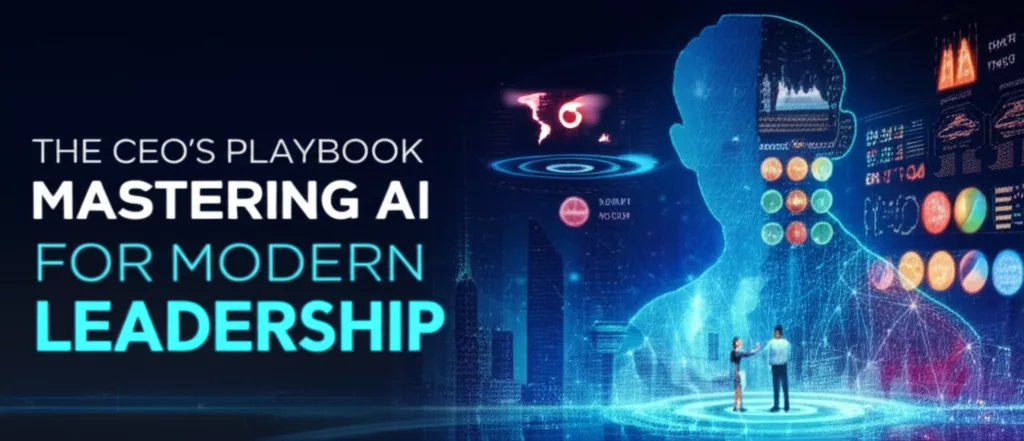Wake Up, Leadership! Your AI Co-Pilot Just Landed.
The age of science fiction is behind us; artificial intelligence is no longer a futuristic fantasy – it’s a present reality firmly embedded in the modern C-suite. More than just a tool, AI is fundamentally changing how top executives approach decision-making, organizational management, and strategic foresight.
Consider AI as the ultimate ‘thought partner,’ equipped to process vast datasets, identify subtle trends, and elevate strategic thinking to unprecedented levels. This isn’t mere automation; it’s a cognitive collaboration poised to redefine leadership in the digital era.

I. The AI Story: From Calculating Machines to Creative Geniuses
- The Early Days (Think Mad Men, but with Mainframes): Let’s journey back to the 1970s and 80s, an era characterized by rudimentary “expert systems.” These were clunky, rule-based technologies designed to mimic human reasoning within specific domains such as finance and medicine. Though their capabilities were limited, these early systems laid crucial groundwork, demonstrating the potential for machines to aid in complex decision-making processes.
- The Data Boom & Learning Machines (90s & 00s): Fast forward to the 1990s and 2000s, a period marked by an exponential increase in computing power and data availability. This era ushered in the age of machine learning. Retail giants such as Amazon and Walmart leveraged machine learning to optimize supply chains and personalize marketing efforts. This transformative shift allowed AI to move beyond mere data processing and into the realm of predictive analytics.
- Big Data & Real-Time Revelation (2010s): As data volumes continued to swell, AI became indispensable, providing executives with real-time insights and reducing analysis times by an impressive 40%. The democratization of AI began, broadening its accessibility. Organizations equipped themselves with the capacity to harness these tools without requiring specialized knowledge, leveling the playing field and enabling widespread adoption.
- The Generative AI Gold Rush (Today!): Now, we stand at the threshold of a new frontier: generative AI (GenAI). Across the C-suite, leaders are deploying GenAI to generate text, images, code, and transform various facets of business operations from marketing to product development. GenAI is about creation, and its vast potential extends beyond automating existing tasks.
II. The CEO’s Report Card: What Leaders Really Think (and Do)
- Unanimous “YES!”: Top executives overwhelmingly recognize AI’s central role in their corporate strategy. It is a “game-changer” and an “imperative,” underscoring AI’s move from optional tool to critical component.
- Productivity Power-Up: Executives are embracing AI to increase personal and organizational productivity by automating routine tasks and focusing on strategic initiatives and core business goals.
- Leading by Example: Leadership commitment to AI is demonstrated by executives actively using GenAI tools in their daily routines. Over half of C-level leaders use GenAI regularly, setting a powerful example for their organizations.
- The Great Upskilling Mission: Companies are prioritizing training initiatives to equip employees with the skills to effectively use AI. AI is viewed as a partner that enhances human abilities rather than replacing them.
- The Pressure Cooker: There is a palpable sense of urgency in deploying AI technologies. Many CEOs acknowledge that their competitors have already made significant strides in AI implementation, intensifying pressure to transition from strategic planning to tangible execution.
III. Bumps in the Road: AI’s Tricky Side
- “Is Our C-Suite AI-Ready?” (The Elephant in the Boardroom): A major challenge is the lack of confidence among CEOs that their executive teams possess sufficient understanding of AI, hindering effective leadership.
- Garbage In, Biased Out: Flawed or biased data can lead to biased AI decisions, creating ethical and legal challenges.
- The “Black Box” Mystery: The lack of transparency in AI decision-making processes complicates oversight and accountability.
- Who’s Accountable? (Passing the Buck?): Determining accountability for AI-related errors is a significant governance issue.
- Privacy Panic & Security Scares: The use of sensitive personal data by AI systems raises privacy concerns and compliance challenges.
- The Job Fear Factor: Employees fear job displacement due to AI, highlighting the need for reskilling initiatives.
- The ROI Riddle & Pilot Perils: Many companies struggle to demonstrate a clear return on investment (ROI) from AI projects.
- “Shadow AI” & Wild West Woes: Unauthorized use of AI tools by employees creates governance and security risks.
- Losing Our Human Touch? Over-reliance on AI could diminish human intuition and judgment.
IV. The Crystal Ball: What’s Next for AI and Leaders
- Rise of the AI Agents (Your Autonomous Assistants): The future will see AI agents autonomously executing complex workflows and making decisions.
- AI-First Everything: AI will be integrated into every aspect of the organization, driving strategy and innovation.
- Ethics at the Core: Responsible AI governance will be paramount, with leaders championing fairness, privacy, transparency, and accountability.
- Decision Intelligence on Steroids: AI will deliver faster, more accurate, and proactive insights.
- The Human-AI Symphony: The workforce will transform, with humans handling creativity and AI taking on rules-based work.
- Sustainability on the Agenda: “Green AI” and energy-efficient architectures will become strategic differentiators.
- Hyper-Personalization & Cybersecurity Reinvented: Deeper customer engagement and tighter cybersecurity will emerge.
Conclusion: Lead with AI, Lead the Future.
AI brings both opportunities and challenges to leadership, requiring a blend of analytical insight, ethical judgment, and strategic vision. Leaders must educate themselves, govern AI wisely, and prepare their organizations for an AI-led future.

